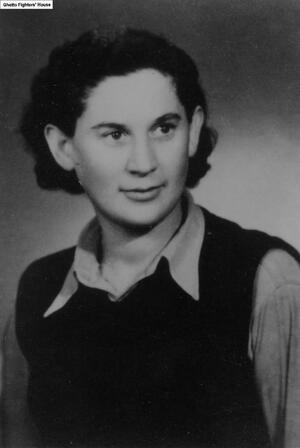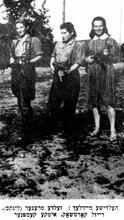Chajka Klinger
Chajka Klinger, born to a Hassidic family in Bedzin, Poland, was a member of Ha-Shomer ha-Za’ir and a leader in the resistance against the Nazis in Bedzin. When the destruction of the Bedzin ghetto loomed, her mission was to live so that she could keep the flame and memory of resistance alive. She escaped Bedzin after being captured and tortured, and fled to Palestine. Her diaries were the first written evidence about the Warsaw Ghetto uprising to escape Nazi Europe, and she spread the word across Palestine about the horrors of the Holocaust and the Jewish uprisings in Poland. She remained in Palestine after the war but suffered from survivor’s guilt and mental health issues for the rest of her life.
“The avant-garde must die where its people are dying.” Chajka Klinger repeated this dictum several times in her diaries. For her it was the ultimate motive for the ghetto uprising.
Early Life
Chajka Klinger was born in 1917 in Bedzin (southwest Poland). Her father Lajbus (Leib, c. 1883–Auschwitz 1943) was a A member of the hasidic movement, founded in the first half of the 18th century by Israel ben Eliezer Ba'al Shem Tov.hasid who dedicated his life to the study of the Lit. "teaching," "study," or "learning." A compilation of the commentary and discussions of the amora'im on the Mishnah. When not specified, "Talmud" refers to the Babylonian Talmud.Talmud. Her mother Perl (Perla, c. 1883–Auschwitz 1943) provided the family’s income by running a small grocery store. Five of their children—Abraham (died before the Holocaust), Sara (d. Auschwitz 1943), Mania (died in a labor camp c. 1944), Menahem Mendel, and Chajka—became Jewish revolutionaries, affiliated with Po’alei Zion, Ha-Shomer ha-Za’ir, and the Communist movements. Chajka attended the Jewish Furstenberg Gymnazium—an unusual education for a Hassidic girl. She distinguished herself in Hebrew, Polish, and German.
HaShomer Ha-Zair
Though at that time Klinger was apparently dreaming of becoming a Polish intellectual, she joined Ha-Shomer ha-Za’ir when she was fourteen and this proved a turning point to a new way of life. From then on her aim was to immigrate to The Land of IsraelErez Israel and to become a A voluntary collective community, mainly agricultural, in which there is no private wealth and which is responsible for all the needs of its members and their families.kibbutz member. Active as a youth leader in 1938, she later moved to Kalisz and joined her friends in the Hakhsharah, staying there for more than a year training towards Lit. "ascent." A "calling up" to the Torah during its reading in the synagogue.aliyah. She planned to immigrate to Erez Israel in September 1939, but the war changed her plans. Her attempt to escape from Poland via Vilna failed. In the spring of 1940 she was instructed by the Ha-Shomer ha-Za’ir leadership in Vilna to stay in Bedzin and rehabilitate movement activity there. Klinger and her companion, David Kozlowski, became the leading figures in the new branch of Ha-Shomer ha-Za’ir in the town. As a result of their activity and the special conditions in the Zaglembie region, which was annexed to the German Reich and where no ghetto was established until 1943, the youth movement in Bedzin flourished during the war. Zaglembie became one of the centers of Jewish youth movements all over occupied Poland, attracting about two thousand youngsters to Bedzin and Sosnowiec. Several leaders of Ha-Shomer ha-Za’ir in Warsaw, including Tosia Altman and Mordechai Anielewicz, stayed in Bedzin for long periods during these years. Chajka also personally knew Yosef Kaplan and Shmuel Berslaw, leading figures of her movement in Warsaw. All of them later became leaders of the Warsaw Ghetto underground and uprising.
In August 1942, following a mass deportation from Zaglembie to Auschwitz, an armed underground was established in Bedzin which included all the active He-Haluz movements (Dror-Freiheit, Ha-Shomer ha-Za’ir, Ha-Shomer ha-Dati, Gordonia, Ha-Noar ha-Ziyyoni). Klinger took an active part in the first meeting of the underground and immediately became one of its leading figures. As a strict adherent of the idea of a Jewish armed resistance she rejected any rescue option. She believed there was only one way to respond to the Nazi annihilation of the Jews: a Jewish revolt.
However, the Bedzin underground suffered numerous losses: women couriers were captured during their missions and murdered; some activists (Lipek Minz and Zvi Dunski) were arrested by the Judenrat, handed over to the Gestapo, and executed; a company of twenty Jewish fighters was ambushed on its way to meet the partisans and only one survived. By July 1943, Klinger had lost many of her friends including her boyfriend Kozlowski. Finally, all of her comrades from the Warsaw Ghetto were killed during the Warsaw uprising (April–May 1943).
Sentenced to Live
Though she still believed in the idea of a Jewish revolt, the underground’s plans demanded that she fight not with weapons but with words. She was “sentenced to live,” to survive the battles and to document them for future generations. On August 1, 1943, the final liquidation of the ghetto was launched. During the last deportation of the Jews of Bedzin Klinger was captured by the Nazis with a revolver in her wallet. Severely tortured by the Gestapo, she survived the interrogation without informing on any of her comrades.
Henceforth she had only one reason to survive: recording the history of the underground in Zaglembie and Warsaw. This she did following her escape from Bedzin, while hiding in a small village in the vicinity. In December 1943 she crossed the border to Slovakia with other survivors of the Bedzin underground, bringing her diaries with her. For her friends in Slovakia and Hungary, rescuing and delivering her diaries to Erez Israel became an important mission, in which they eventually succeeded. They were the first written evidence about the Warsaw uprising and the Bedzin underground.
In March 1944 Klinger arrived in Palestine. At first she spent a few months traveling all over the small country, telling her shocked listeners the story of the gas chambers and the Jewish uprising, feeling guilty that she survived while her friends died. In 1944 she married Ya’akov Rosenberg-Ronen (b. 1917) and settled in Kibbutz Ha-Ogen where she tried to rewrite and edit her diaries for publication, a task she never accomplished.
Thereafter she decided to try to bury her memories and begin a new life. Chajka Ronen gave birth to three children—Zvi (b. 1945), Avihu (b. 1948), and Aron (b. 1956)—trained herself in several professions and made an effort to become a good kibbutznik. But either she failed or perhaps it was the young kibbutz that failed to understand her. She suffered several mental crises, was twice hospitalized, and on April 18, 1958, just before the fifteenth anniversary of the Warsaw Ghetto uprising, committed suicide.
Her book, A Diary from the Ghetto (Mi-Yoman ba-Ghetto), was published posthumously (1959), heavily edited because of incomplete manuscripts (three versions) and censored because of Chajka’s critical attitudes toward the Zionists in the Zaglembian Judenrat and the Jewish leadership in Palestine.
Klinger, Chajka. I Am Writing These Words to You: The Original Diaries, Bedzin 1943. ed. Avihu Ronen. Tel Aviv: Yad Vashem Publications and Moreshet Publications, 2017.
Klinger, Chajka. Miyoman Bagetho (Hebrew), Tel Aviv: Sifriat Poalim, 1959.
Klinger, Chajka. (Forthcoming) Skazani nażycie: Pamiętnikii życie Chajka Klinger, (Polish translation of Condemned to Life), trans. Michael Sobelman. Warsaw: Żydowski Instytut Historyczny (ŻIH) and Instytut Pamięci Narodowe, 2021.
Klinger, Chajka and Aharon Brades, "El divrei ha-Edut" (Hebrew), Mishmar, March 17 1944.
Ronen, Avihu. Nidona Lechaim: Yomaneiha ve chaieh shel Chjaka Klinger (Hebrew). Tel Aviv: Haife University Publications, Yediot Sfarim, 2011.
Ronen, Avihu. "Pamiętniki Chajki Klinger", Zagłada Żydów. Studiai Materiały, Pismo Centrum Badań nad Zagładą Żydów. Vol. 9 (Dec. 2013), 335-345.
Ronen, Avihu. "The Secret Telegram: Tabenkin-Yaari Telegram to the Survivors of the Ghetto Fighters, Yad Vashem Studies, Vol. 41:2 (2014), 95–138.
Ronen, Avihu. “To Write and to Live: On Chajka Klinger’s Diaries", Moreshet: Journal for the Study of the Holocaust and Antisemitism, Vol. 10 (Dec. 2013), 175–210.




